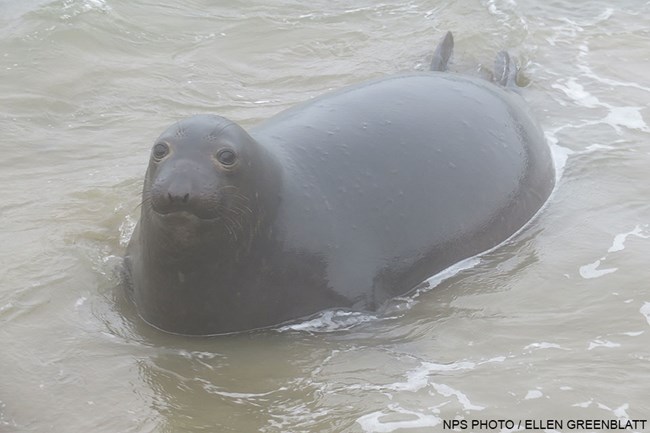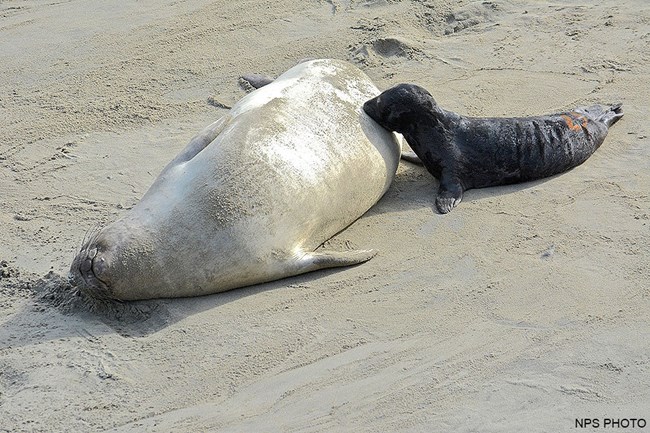Part of a series of articles titled Elephant Seal Tales.
Article
January: Pups, Pups, Pups! – Bringing Forth the Next Generation

January is a jam-packed, happening month for female elephant seals. When the cows, as females are known, turn up on Point Reyes beaches around the start of January, they are pregnant and ready to give birth after their months-long feeding trip. Within days, they give birth and start nursing their single pups, all the while fasting. Then, a few weeks later, just as they are weaning their pups, they enter estrus, mate, and head back out to sea. At this point, we lose visual track of them for the next several months as they hunt in dives that average 2,000 feet, but can go as deep as an astonishing 5,000 feet.
The dramatic January occurrences, particularly births, are the ones we on land can see, and, luckily, the eyes and descriptions of Point Reyes National Seashore volunteers serve us well. Peggy McCutcheon, a longtime Winter Wildlife Docent, notes that births normally take place very quickly. "First, you see a sea of the backs of the cows. Then, sometimes, you see a rear end flip, and some blood, and then there's a new pup. If you miss the moment, you know it's happened because the ravens and gulls are on the scene immediately eating the afterbirth."
One time, Peggy spotted a cow a bit separated from the harem, with her rear end perpendicular in the air. "I observed orange debris near her tail, and, when I looked through the scope, I could see the pup moving inside her." Despite a howling storm with "sideways rain," she and the other volunteers stayed, and, as they saw the pup crowning, they all started cheering, "Push!" from a distance. In a moment, the cow "stopped undulating her tail, and with one final flip of her rear end, out came the pup!" The excitement in Peggy's voice as she told the story reflects the passion of the Point Reyes Winter Wildlife Docents, no matter what the weather."
- Duration:
- 59 seconds
A 59-second-long video of a female elephant seal giving birth at Drakes Beach on January 31, 2018.

The newborns have soft black fur, which absorbs heat and helps keep the still-almost-blubberless pups warm. (On one unusually warm day, though, Docent Peggy witnessed a cow rolling her black-furred pup into the water to cool him off!) The pups weigh in at birth at about 70 pounds, and their full-time job over the next weeks is to slurp as much as they can of their mother's ultra-rich milk, which, by the end of the nursing period contains as much as 55% fat. (Compare that to the 3–5% fat content of human mothers' milk.) These "only-child" pups have to eat rapidly and efficiently before they are abruptly weaned, and the most accomplished nursers top out at over 300 pounds (after only four weeks!) before their mothers leave them behind. The pups must then learn how to swim and hunt on their own.
The best eaters—the pups that gain the most weight—are known as "super weaners," and they usually achieve their weight advantage either by being adopted by cows that have lost their own pups or, as Marianne Reidman notes in her encyclopedic book, The Pinnipeds, by brazenly becoming "milk stealers...sneak[ing] a suckle" from another cow. But the occasional extra suckle cannot fully explain "jumbo pups'' that, according to Reidman, "are sometimes so stout that they have difficulty maneuvering and have been seen tobogganing and somersaulting helplessly down hills like oversized beach balls." Super weaners, mostly male, find ways to connect with and take advantage of nursing females, even seeking a pupless female after their own mothers have weaned them. They become "double-mother sucklers," but it is not clear whether the extra body reserves they accumulate predict either greater rates of survival or a reproductive advantage.
How do the cows keep track of their pups in the crowd? Stacy Hayden, another Winter Wildlife Docent, has a self-described passion for "charismatic megafauna" like elephant seals and great white sharks (she has worked on a shark boat at the Farallons). She has observed that, during the four weeks of nursing, elephant seal cows "make a lot of noise" to encourage their pups to recognize and imprint on them through their unique vocalizations. Cows give birth to just one pup, but occasionally pups get separated from their mothers or inexperienced mothers might abandon their pups. Another cow might try to nurse two pups, but, as Stacy noted, the cows' maternal instinct might well doom both pups to death—the cow simply does not have enough milk to bring two pups to the size where they can make it on their own.
Becoming an orphan is not the only danger pups face. Since they cannot swim, a wave that carries them to sea can result in their drowning. And the bulls, which have no imprinting or protective connection with the pups, are hanging around the harem, waiting to mate as soon as a cow enters estrus. A 3,000–5,000 pound bull can easily run over and crush a pup without even knowing.
Elephant seal cows are pregnant, or at least “sort of” pregnant, almost all the time, except for the four weeks or so when they are nursing pups. After all, they mate right before or immediately after weaning their pups. But a phenomenon called delayed implantation, a concept which doesn't make much sense to those of us accustomed to the human model, means they are only "sort of" pregnant for months of that time.
Teaser: more on the phenomenon of delayed implantation in Episode 3 of Elephant Seal Tales—the Valentine's Day edition.
Because the pandemic is keeping Point Reyes National Seashore Docents from doing what they love best—interacting and explaining seals' behavior to the public—upcoming articles will attempt to provide month-to-month information and reflections on what all the activity means, including more anecdotes and interpretation by volunteers!

Be sure to check back for each update. And, if you find the volunteers' on-the-scene anecdotes tantalizing, visit our Point Reyes National Seashore's Volunteer page to learn more about volunteering and making a difference!
By Ellen Greenblatt, Point Reyes National Seashore Volunteer
Disclaimer: National Park Service scientists took the photos and video of elephant seals contained on this page while conducting scientific research. As per the Marine Mammal Protection Act, park scientists have a permit from the National Marine Fisheries Service to enter elephant seal protection areas that are otherwise closed to the public. Disrupting behavioral patterns of seals is prohibited and park scientists have been trained to reduce the possibility of disturbing the seals. Please adhere to all elephant seal protection closures, and stay at least 25 feet away from seals outside of the protection closures. Check out these seal viewing tips for more information.
Last updated: January 27, 2021
